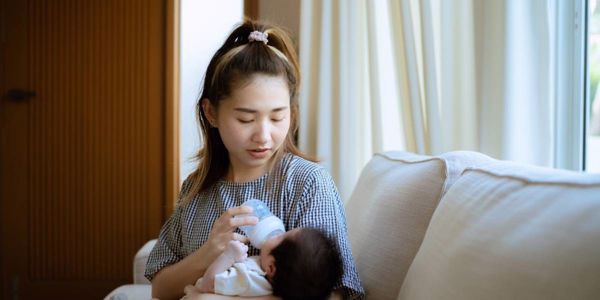The umbilical cord begins to form around the 4-week mark of pregnancy.
In pregnancy, the umbilical cord is your baby’s lifeline to your placenta. The placenta is the organ that implants itself into your uterus. The role of the umbilical cord is to deliver the vital nutrients from your body to your baby and remove all of the waste products that your baby produces.
The umbilical cord is usually around 20 inches long and is about 1 inch thick. The cord is made up of three blood vessels, a vein that carries oxygen-rich blood from your circulatory system and important nutrients to your baby. It also has two arteries that deliver the oxygen-depleted blood and any waste products your baby makes back to you. Your lungs will then replenish the blood with oxygen and your kidneys will process and dispose of your baby’s waste in the same way it does yours.
How Long Does It Take for the Umbilical Cord To Fall Off?
After birth the umbilical cord will be clamped and cut, leaving a small stump behind. The leftover umbilical cord that is still attached to your baby will dry up over the first couple of days and will eventually fall off anywhere between 7 days to 21 days post-birth. Up until the cord falls off, you will need to take care and keep it clean and dry. (If your baby cord hasn’t come away after 3 weeks, it's a good idea to take your baby to the doctors so they can take a look as there may be a problem with your baby’s immune system or an infection).
You do not need to worry unless there are signs of an infection. As the umbilical cord stump dries up it will go from a green/yellow colour to brown and then to black. Your only job during this process is to keep the stump dry and clean.
A small wound may be left behind once the cord falls off and it may take a few days to heal. If it falls off earlier than 7 days and there are no signs of infection or excessive bleeding - don’t panic, this is ok too!
How to Care for the Umbilical Cord
1 - Keep the Stump Clean and Dry
To keep the umbilical stump clean around the base, use warm water mixed with a mild soap and then make sure to dry the area thoroughly. You do not need to clean the stump itself unless something gets onto it (nappy explosions being one scenario) if this happens, then clean the stump with warm water and dry it thoroughly afterwards.
Airing the stump also helps to dry out the base of the stump quickly.
2 - Sponge Baths
Sponge baths make it easier to keep the stump dry compared to regular baths. When sponging down your newborn you simply wipe or dab the areas that need cleaning with either warm water on its own, or warm water with a bit of baby wash. don’t panic if the stump still gets wet - just dry it thoroughly after.
3 - Clean Up the Stump if Anything Gets on It
To help prevent infections use cotton pads of a cloth/flannel that has soap and water on it to clean the dirtied part of the cord. Make sure to pat the cord dry after and then leave the stump exposed to air.
4 - Let the Stump Fall Off on Its Own
Do not attempt to pull the cord off yourself, allow it to fall off on its own.
What Should You Do When the Umbilical Cord Falls Off?
In the same way that a scab may bleed slightly as it comes away, When the stump does fall off it is normal for there to be a little bit of blood on your baby’s nappy. However, if you notice your baby’s belly button is actively bleeding and applying gentle pressure isn’t making a difference, or if it begins bleeding again after stopping, give your doctor a call. Bleeding that doesn’t stop may be a sign of a bleeding disorder or infection.
Signs There Is a Problem
In about 1 in 500 newborns, when the stump falls off there can be some drainage of clear or yellow looking fluid. Sometimes bits of pink lumpy flesh - also known as scar tissue, may be left behind. This scar tissue is called an umbilical granuloma. Granulomas are harmless but if they are not treated, they can grow in size and become an entry point for infections. Most granulomas will disappear on their own in around 7 days but if it hasn’t, reach out to your doctor.
If your baby's belly button is noticeably bulging, your baby may have an umbilical hernia. Umbilical hernias appear as a result of the opening to your baby’s abdomen not closing on its own. In this case, part of your baby’s small intestine pops through the opening - even more so if your baby is crying or straining when trying to poo.
Umbilical hernias don’t usually cause any issues. Surgery is rarely ever needed to close these hernias, as 90% of umbilical hernias close on their own by the time your little one turns 4. But of course, if you notice that your child has any swelling, discolouration or is experiencing tenderness in the area then consult your doctor. In rare cases, if your little one's intestine gets caught and has the blood supply cut off, surgery is necessary.







